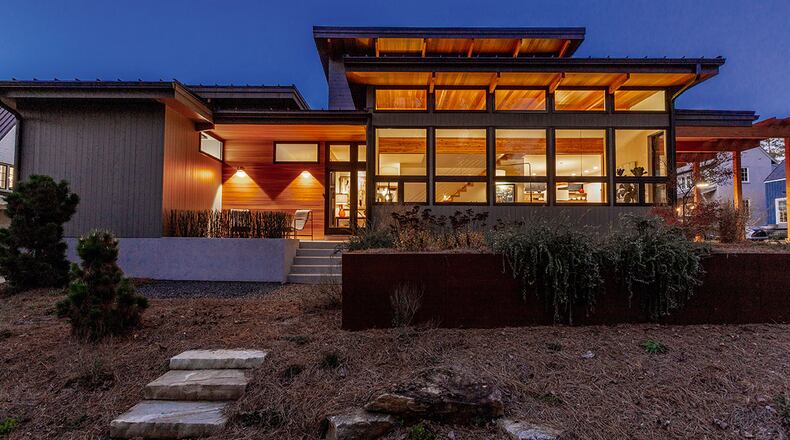I live in the city of Atlanta, in a small neighborhood on the southeast side. My neighborhood is ranked the 10th most diverse of 167 neighborhoods in Atlanta and the 39th best neighborhood to buy a house among 165 Atlanta neighborhoods, according to Niche.com.
Recently, during a walk down my block, I noticed a stunner of a home that seemed to have cropped up out of nowhere — a two-story, 2,500-square-foot new build, single-family home featuring five bedrooms and four bathrooms.
This isn’t an outrageously huge home — the square footage is only slightly larger than the average American home — but it is located amid modest two-bedroom, one-bathroom homes with a reported median value of $266,386.
The location made the $749,000 price tag a bit more noticeable.
“Builders are buying up the post WWII Cape Cods for $400,000,” wrote one of my neighbors on Niche.com in 2018. “The original homes are demolished and new two-story homes with multiple bed and baths erected and sell (sic) for $750,000 to $1.4M.”
When I mentioned this trend to friends and colleagues, it was clear this isn’t just an issue in my neighborhood. It’s happening in neighborhoods across metro Atlanta — West End, Brookhaven, Dunwoody.
Conversations on the topic inevitably turn to gentrification, but shouldn’t we also be talking about preservation? Isn’t it possible, even desirable, to design and build homes that will attract new homebuyers and uplift property values without upsetting the character of a neighborhood?
Sheri Koones has built a career on demonstrating that bigger houses aren’t always better. Koones lives in Greenwich, Connecticut, a place where houses could easily be mistaken for hotels, she said. When her children left for college, she and her husband downsized from a 6,800-square-foot home to a 1,700-square-foot condo.
Koones got rid of 90% of her stuff and discovered she didn’t need it. Now she writes about the virtues of living in well-designed homes that are beautiful, environmentally friendly and while they may be on the higher end of pricing, they range somewhere between 600 and 2,000 square feet.
“It once was a status symbol to build very large houses, but I don’t think it is a status symbol anymore,” said Koones, whose recently released book, “Bigger Than Tiny, Smaller Than Average” (Gibbs Smith, $35), serves as an educational guide to small but mighty home design. “The trick is to build a house that works for you, even if it is small.”
In 1973, we weren’t so hung up on home size. The average square footage of a house in the U.S. was 1,660 square feet, according to a recent report from Rocket Mortgage. By 2015, that number jumped to 2,687 square feet, but in 2019, the most recent year for which there is data, the average square footage of a home had dropped to 2,301 square feet.
“There is a huge trend in this country of people looking for smaller houses,” said Koones. Millennials and baby boomers, the only two generations anyone ever seems to talk about, are gravitating to smaller homes, she said.
Some examples in the book include a home in metro Atlanta’s agrihood, Serenbe. At 1,828 square feet, it is on the smaller side but has a modern aesthetic that is connected to the outdoors. Another home, in San Francisco, is a renovation of a 1,593-square-foot home, which added midcentury updates to an existing Victorian design developed in the 1880s. The updates allow more natural light and improve energy efficiency, but in order to retain the home’s character, the homeowners resisted any changes to the exterior or adding square footage.
Credit: Gibbs Smith
Credit: Gibbs Smith
As a result, their new home feels bigger but doesn’t look out of place among the historic cottages.
These types of projects are happening all over the country, said Koones. “It was a very conscious effort of all of these people to build smaller. It is really important that people build houses that kind of fit in with the local area.”
Why then do we keep seeing big, expensive houses popping up in neighborhoods with moderately priced, modest-sized homes?
Cheri Benjamin, an Atlanta-based real estate agent with more than 22 years experience selling homes in almost every region of the country, said it takes time for housing trends to work their way over to Georgia.
The demand for smaller homes with modern style began on the West Coast and is only just moving to the South, she said.
Georgia outpaced the national average in population growth from 2010 to 2020, growing 10%, according to census data. The average appreciation of homes used to be 4% to 6%, said Benjamin, but during the pandemic, it jumped to 20%.
While we continue to view homeownership as a pathway to wealth, some of that wealth is no longer going to homeowners, she said.
“Our residential market is typically a transfer of wealth from homeowner to homeowner, but it has become a transfer of wealth from homeowner to corporation,” Benjamin said. Companies are scooping up homes as-is and off market, priced at $650,000 or less (a price Benjamin considers middle America), then reselling them for $20,000 to $50,000 more, she said.
“Investors will at least put lipstick on a pig, but corporations are merely relisting the home for what the homeowner could have received,” said Benjamin. When corporations purchase multiple homes in an area, it allows them to control the market, she said. “That should be scary to any homeowner.”
I’m not sure about the motives of the investor or individual who built the home in my neighborhood, but I believe Georgia homebuyers are at the start of a new trend.
Even in this hot real estate market, the price on that house is down $60,000 from when it was first listed, which gives me hope that buyers in the future will force developers to focus more on preserving the character of neighborhoods than building the biggest house for the highest price.
Read more on the Real Life blog (www.ajc.com/opinion/real-life-blog/) and find Nedra on Facebook (www.facebook.com/AJCRealLifeColumn) and Twitter (@nrhoneajc) or email her at nedra.rhone@ajc.com.
About the Author
Keep Reading
The Latest
Featured



